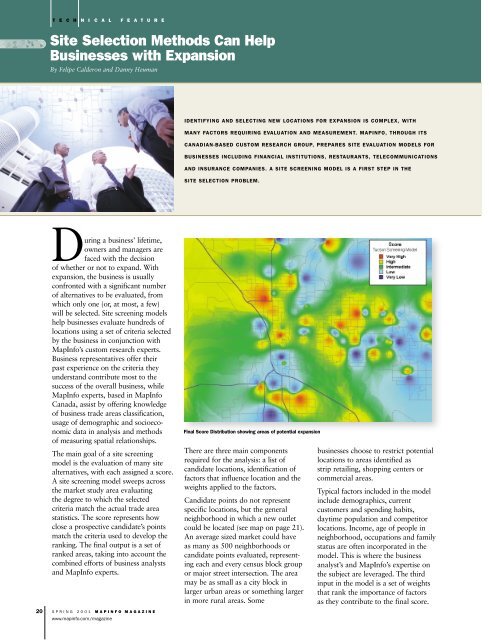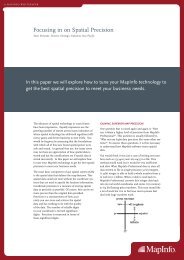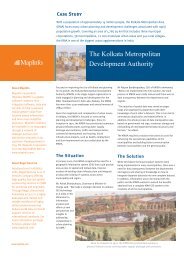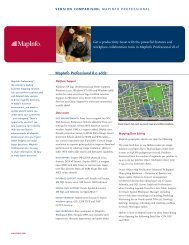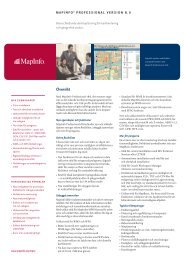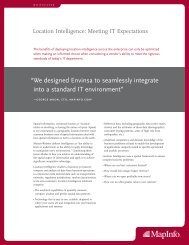mapinfomag_spring200..
mapinfomag_spring200..
mapinfomag_spring200..
Create successful ePaper yourself
Turn your PDF publications into a flip-book with our unique Google optimized e-Paper software.
20<br />
T E C H N I C A L F E A T U R E<br />
Site Selection Methods Can Help<br />
Businesses with Expansion<br />
By Felipe Calderon and Danny Heuman<br />
During a business’ lifetime,<br />
owners and managers are<br />
faced with the decision<br />
of whether or not to expand. With<br />
expansion, the business is usually<br />
confronted with a significant number<br />
of alternatives to be evaluated, from<br />
which only one (or, at most, a few)<br />
will be selected. Site screening models<br />
help businesses evaluate hundreds of<br />
locations using a set of criteria selected<br />
by the business in conjunction with<br />
MapInfo’s custom research experts.<br />
Business representatives offer their<br />
past experience on the criteria they<br />
understand contribute most to the<br />
success of the overall business, while<br />
MapInfo experts, based in MapInfo<br />
Canada, assist by offering knowledge<br />
of business trade areas classification,<br />
usage of demographic and socioeconomic<br />
data in analysis and methods<br />
of measuring spatial relationships.<br />
The main goal of a site screening<br />
model is the evaluation of many site<br />
alternatives, with each assigned a score.<br />
A site screening model sweeps across<br />
the market study area evaluating<br />
the degree to which the selected<br />
criteria match the actual trade area<br />
statistics. The score represents how<br />
close a prospective candidate’s points<br />
match the criteria used to develop the<br />
ranking. The final output is a set of<br />
ranked areas, taking into account the<br />
combined efforts of business analysts<br />
and MapInfo experts.<br />
SPRING 2001 MAPINFO MAGAZINE<br />
www.mapinfo.com/magazine<br />
IDENTIFYING AND SELECTING NEW LOCATIONS FOR EXPANSION IS COMPLEX, WITH<br />
MANY FACTORS REQUIRING EVALUATION AND MEASUREMENT. MAPINFO, THROUGH ITS<br />
CANADIAN-BASED CUSTOM RESEARCH GROUP, PREPARES SITE EVALUATION MODELS FOR<br />
BUSINESSES INCLUDING FINANCIAL INSTITUTIONS, RESTAURANTS, TELECOMMUNICATIONS<br />
AND INSURANCE COMPANIES. A SITE SCREENING MODEL IS A FIRST STEP IN THE<br />
SITE SELECTION PROBLEM.<br />
Final Score Distribution showing areas of potential expansion<br />
There are three main components<br />
required for the analysis: a list of<br />
candidate locations, identification of<br />
factors that influence location and the<br />
weights applied to the factors.<br />
Candidate points do not represent<br />
specific locations, but the general<br />
neighborhood in which a new outlet<br />
could be located (see map on page 21).<br />
An average sized market could have<br />
as many as 500 neighborhoods or<br />
candidate points evaluated, representing<br />
each and every census block group<br />
or major street intersection. The area<br />
may be as small as a city block in<br />
larger urban areas or something larger<br />
in more rural areas. Some<br />
businesses choose to restrict potential<br />
locations to areas identified as<br />
strip retailing, shopping centers or<br />
commercial areas.<br />
Typical factors included in the model<br />
include demographics, current<br />
customers and spending habits,<br />
daytime population and competitor<br />
locations. Income, age of people in<br />
neighborhood, occupations and family<br />
status are often incorporated in the<br />
model. This is where the business<br />
analyst’s and MapInfo’s expertise on<br />
the subject are leveraged. The third<br />
input in the model is a set of weights<br />
that rank the importance of factors<br />
as they contribute to the final score.


